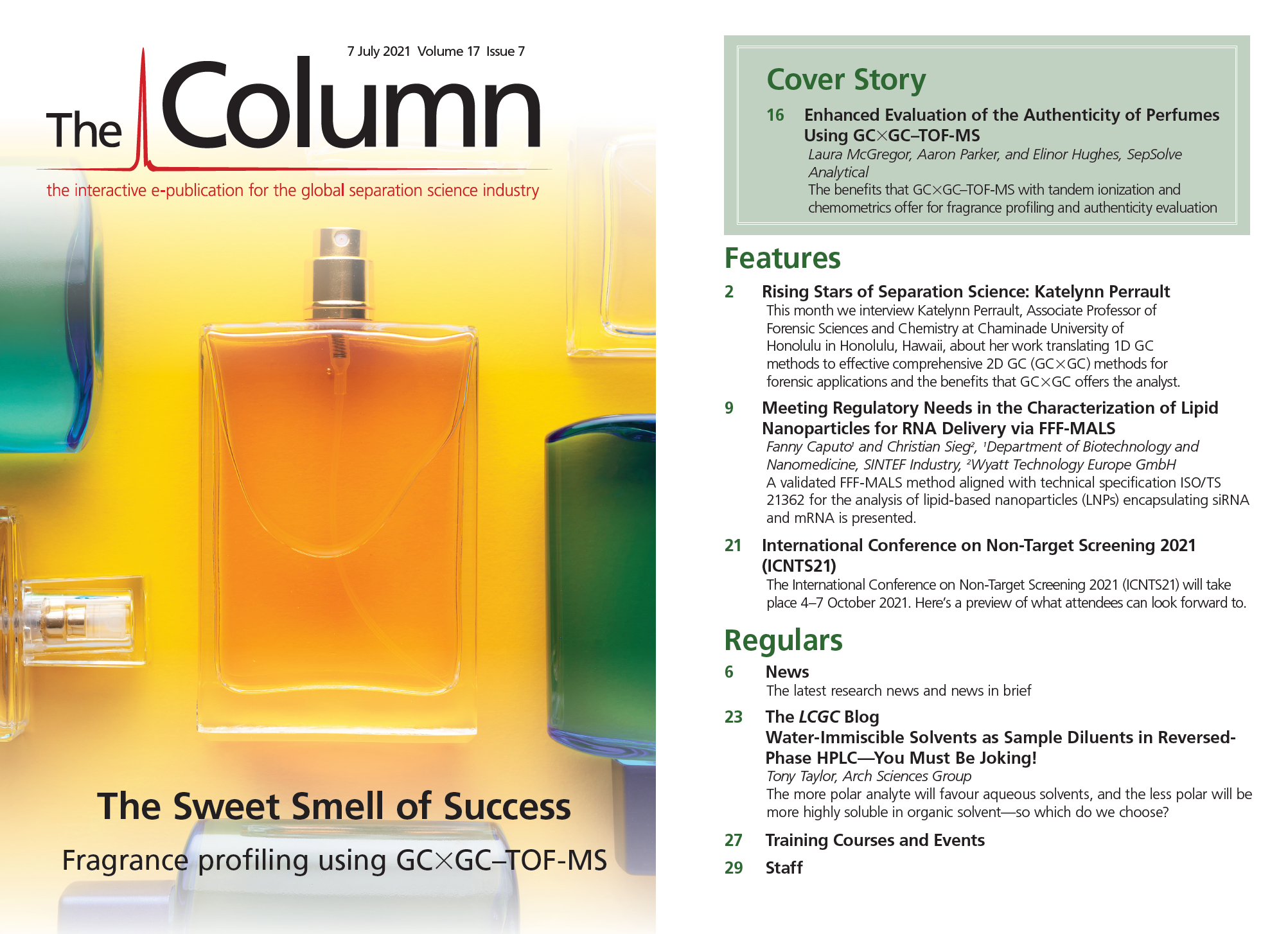Enhanced Evaluation of the Authenticity of Perfumes Using GC×GC–TOF-MS
The global perfumes market was valued at over $30 billion in 2019 and is expected to continue growing. It is perhaps inevitable that this has been accompanied by a rise in counterfeit products, sold at significantly lower prices compared to the luxury brands they imitate. Comprehensive data acquired using two-dimensional gas chromatography with time-of-flight mass spectrometry (GC×GC–TOF‑MS) combined with tandem ionization—simultaneous hard and soft electron ionization—data can be used to uncover subtle differences between brand and imitation perfumes.
Counterfeit perfumes, and their packaging, are often so similar to the authentic perfumes that consumers may be unable to distinguish between genuine and imitation goods. Reliable quality and authenticity tests are important to ensure consumers do not receive an inferior product, to protect brand reputation, and to reduce loss of revenue.
However, the diverse range of chemical classes in perfumes requires advanced separations to resolve coelutions to provide identification of the analytes present. Comprehensive two-dimensional gas chromatography with time-of-flight mass spectrometry (GC×GC–TOF-MS) can tackle this challenge, as it is capable of separating compounds that would normally coelute with one-dimensional GC. This is because with GC×GC, two columns of different selectivity separate the analytes based on two different chemical properties (for example, volatility and polarity).
Another challenge is that perfumes contain structurally similar compounds (such as terpenes) that can be difficult (or impossible) to speciate when using conventional 70 eV electron ionization (EI), even with the increased separation capacity of GC×GC. Tandem ionization, which provides both hard and soft EI data in a single analysis, can overcome this problem. The complementary soft EI spectra improves chemical selectivity to enhance untargeted ”discovery” workflows, as required in quality and authenticity evaluation, where you may not know what compounds can be used to differentiate between genuine and imitation products.
Here, we show how the comprehensive data acquired using GC×GC–TOF-MS with tandem ionization can be processed in a single, automated workflow to uncover the subtle differences between brand and imitation fragrances for quality and authenticity evaluation.
Experimental
Three brand perfumes and three imitation perfumes were analyzed in triplicate by GC×GC–TOF-MS. The perfumes had three distinct scents: blackberry, pomegranate, and lime. GC×GC: Insight flow modulator (SepSolve Analytical); Modulation period (PM): 3.6 s. MS: Instrument: BenchTOF2‑TI (SepSolve Analytical); Mass range: m/z 35–600; Acquisition rate: 100 Hz in tandem ionization mode at 70 and 14 eV. Software: Full instrument control and data processing by ChromSpace with ChromCompare+ (SepSolve Analytical) for untargeted chemometrics.
Results and Discussion
In this study, three luxury brand perfumes and their imitation versions were analyzed. As seen in Figure 1, the brand and imitation fragrances share similar compositions; however, there are differences that can be uncovered easily by GC×GC–TOF-MS.

Here, tandem ionization was also utilized to improve the selectivity for compounds that share similar spectra at 70 eV (such as terpenes). This enabled both hard and soft EI data to be acquired simultaneously in a single workflow for complementary chemical information with no added analysis time. Figure 2 shows the “tandem” data file, which contains both MS data blocks. Using the tandem format, both sets of spectra were searched simultaneously against hard and soft ionization libraries.

Tandem ionization is especially useful in the case of isomer identification, such as the diverse range of terpenes and terpenoids found in fragrances. For example, Figure 3 shows spectral comparisons for two isomers of guaiene, with enhanced differences in ion ratios obtained when using soft EI.

In this study, the tandem ionization data was also used to improve discovery of true differences between the brand and imitation perfumes, using novel automated workflows in the software.
This approach divides the chromatogram into small tiles and sums the signal for every individual m/z channel in each tile for comparison between samples. Time‑consuming pre-processing steps, such as integration and identification, are eliminated and all the raw data is used, minimizing the risk of missing important details. By utilizing both sets of MS data in a single workflow, discovery of true differences is improved through reduction of false positives.
The principal components analysis (PCA) score plot in Figure 4 shows the comparison of all six perfumes (run in triplicate). The brand and imitation versions of the pomegranate fragrance appear to be most similar in composition as they cluster closely in the PCA plot, while those of lime and blackberry appear to be more distinct.

Using a feature discovery tool in the software, the top 10 differentiating features between the brand and imitation versions were found for each fragrance and were identified using the TOF-MS (Figure 5).

Interestingly, the imitation pomegranate fragrance was found to contain the two isomers of lyral (also known as 3- and 4-(4-hydroxy-4-methylpentyl)cyclohex3-ene-1-carbaldehyde, or HICC). Lyral is now banned under Regulation (EU) 2017/1410 (an amendment to Regulation 1223/2009/EC), due to the high risk of contact allergy associated with this compound (1). The amendment calls for all non-compliant cosmetics to be withdrawn from the market by 23 August 2021.
On the other hand, many of the differentiators found only in the brand perfumes are described as “long-lasting” base notes—such as kephalis and muscenone—and as such, these are potential markers of quality when comparing brand and imitation products.
It is important to note that the use of tandem data to confirm positive hits during feature discovery improved the discovery of subtle, trace differences by suppressing false positives. When the top 50 differences for the brand and imitation fragrances were compared using the tandem data and then using 70 eV data alone, two true differences were listed for the tandem dataset that were not found amongst the top 50 differences when using 70 eV data alone (Figure 6). Therefore, using tandem data to cross‑confirm the positive hits during feature discovery can provide more confidence that true differences have been found, by reducing the number of false positives for review.

Conclusions
This study has shown that GC×GC–TOF-MS with tandem ionization and chemometrics software provides comprehensive fragrance profiling to aid quality and authenticity evaluation. The study demonstrated the enhanced separation of GC×GC, combined with the spectral fidelity of TOF-MS, enabling confident identification of analytes in fragrances. Tandem ionization added an extra level of confidence through complementary hard and soft EI data. Finally, the software enabled fast and simple identification of key quality markers using automated, untargeted data analysis.
References
- Commission Regulation (EU) 2017/1410 of 2 August 2017, amending Annexes II and III to Regulation (EC) No 1223/2009 of the European Parliament and of the Council on cosmetic products, https://eur-lex.europa.eu/legal-content/ EN/TXT/?uri=CELEX:32017R1410
Laura McGregor received an M.Chem. in chemistry from the University of St Andrews, UK, followed by an M.Sc. in forensic science at the University of Strathclyde, UK. Her Ph.D. in environmental forensics focused on the chemical fingerprinting of environmental contamination using advanced techniques such as GC×GC−TOF-MS. In her current role at SepSolve Analytical, she specializes in the application of GC×GC and TOF-MS to challenging applications.
Aaron Parker received a B.Sc. in chemistry at the University of York and has over a decade of experience in developing applications for gas chromatography with a particular focus on GC×GC. In his current position, Aaron is responsible for business development activities for SepSolve’s separations portfolio of products, software, and applications.
Elinor Hughes obtained her B.Sc. in chemistry and Ph.D. in organic chemistry at Bangor University, UK. After working for a chemical manufacturing company for three years, she moved to the Royal Society of Chemistry where she worked in journals publishing for six years and on Chemistry World magazine for four years. This was followed by five years as a freelance copyeditor and science writer. Her current role is technical copywriter at Markes International.

Analysis of Pesticides in Foods Using GC–MS/MS: An Interview with José Fernando Huertas-Pérez
December 16th 2024In this LCGC International interview with José Fernando Huertas-Pérez who is a specialist in chemical contaminants analytics and mitigation at the Nestlé Institute for Food Safety and Analytical Sciences at Nestlé Research in Switzerland, In this interview we discuss his recent research work published in Food Chemistry on the subject of a method for quantifying multi-residue pesticides in food matrices using gas chromatography–tandem mass spectrometry (GC–MS/MS) (1).
The Use of SPME and GC×GC in Food Analysis: An Interview with Giorgia Purcaro
December 16th 2024LCGC International sat down with Giorgia Purcaro of the University of Liege to discuss the impact that solid-phase microextraction (SPME) and comprehensive multidimensional gas chromatography (GC×GC) is having on food analysis.











